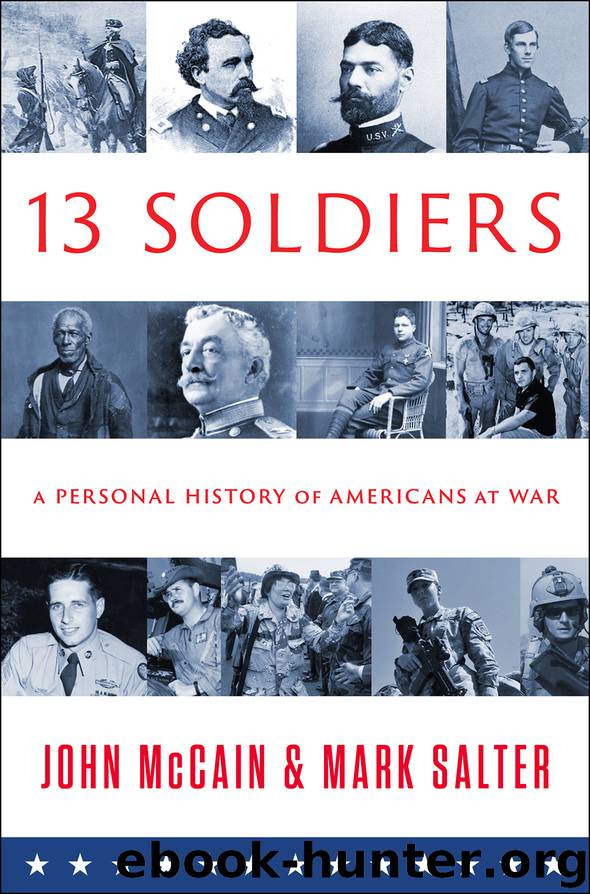Thirteen Soldiers by John McCain

Author:John McCain
Language: eng
Format: epub, azw3
Publisher: Simon & Schuster
PFC Guy Louis Gabaldon poses with a Japanese family he saved from mass suicide on the island of Saipan.
CHAPTER EIGHT
Lone Wolf
Guy Gabaldon, alone and cave by cave, convinced as many as fifteen hundred Japanese on Saipan to surrender.
NO ONE EVER SAID HE lacked guts or initiative. Private first class Guy Gabaldon was as brave as any marine on Saipan during World War II, and more enterprising than many. He had no shortage of bravado either, a common enough, if not universally admired, trait. Some marines felt his exploits were exaggerated and doubted he was quite the lone wolf he claimed to be. Many others believed he earned every bit of the acclaim he received. His company commander praised his courage unreservedly and credited his actions with shortening a campaign that was longer and bloodier than anyone had expected. He recommended Gabaldon for the Medal of Honor.
A marine sergeant on Saipan called Gabaldon “a glory seeker,” but then acknowledged, “The two traits often go together: bravery and glory seeking.” So does the sort of enterprise Gabaldon possessed: daring, foolhardy, and individualistic to the point of insubordination. Courage was a common virtue in a three-week Saipan campaign where nearly fourteen thousand Americans would be killed or wounded. And many marines and soldiers who fought there showed initiative again and again in solving problems posed by difficult terrain and a tenacious, desperate enemy. The initiative Gabaldon took, at great peril to himself, helped spare even more lives, American and Japanese, from the prodigious killing that characterized the Battle of Saipan.
Gabaldon’s war began and ended in the Marianas, a group of islands in the Pacific Ocean west of the Philippines. But to appreciate fully what he did there, and to understand the nature of the challenge Americans faced there, it is instructive to consider an earlier battle on a flyspeck of an island on the west side of a small atoll in the Gilbert Islands.
While General Douglas MacArthur’s army slogged through northern New Guinea toward his rendezvous with destiny in the Philippines, Admiral Chester Nimitz opened the island-hopping campaign in the central Pacific that was the necessary prelude to the invasion of the Japanese home islands. In November 1943 Operation Galvanic, the invasion of Tarawa—specifically the invasion of an islet at Tarawa called Beito—was the first offensive of the campaign. Tarawa is shaped like a triangle, with a wide coral reef and thirty coral islets enclosing a lagoon. Beito is the largest of the islets, but still tiny at three miles in length and a half mile across at its widest point. It is hard to imagine such a small, unimposing place possessing strategic significance, but it did. Before the Allies could invade the home islands, they needed air bases in the northern Marianas, where they could base strategic bombers capable of reaching Japan. To take the Marianas they needed air and naval bases in the Marshall Islands. To take the Marshalls they had to invade Tarawa, from where the Japanese could threaten the sea routes from Hawaii to the Marshalls.
Download
This site does not store any files on its server. We only index and link to content provided by other sites. Please contact the content providers to delete copyright contents if any and email us, we'll remove relevant links or contents immediately.
| American Revolution | Civil War |
| US Presidents |
Fanny Burney by Claire Harman(26490)
Empire of the Sikhs by Patwant Singh(22912)
Out of India by Michael Foss(16758)
Leonardo da Vinci by Walter Isaacson(13114)
Small Great Things by Jodi Picoult(6876)
The Six Wives Of Henry VIII (WOMEN IN HISTORY) by Fraser Antonia(5364)
The Wind in My Hair by Masih Alinejad(5014)
A Higher Loyalty: Truth, Lies, and Leadership by James Comey(4803)
The Lonely City by Olivia Laing(4713)
The Crown by Robert Lacey(4695)
Millionaire: The Philanderer, Gambler, and Duelist Who Invented Modern Finance by Janet Gleeson(4307)
The Iron Duke by The Iron Duke(4258)
Papillon (English) by Henri Charrière(4153)
Sticky Fingers by Joe Hagan(4071)
Joan of Arc by Mary Gordon(3987)
Alive: The Story of the Andes Survivors by Piers Paul Read(3929)
Stalin by Stephen Kotkin(3831)
Aleister Crowley: The Biography by Tobias Churton(3540)
Ants Among Elephants by Sujatha Gidla(3368)
